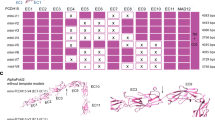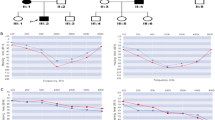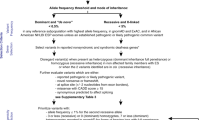Abstract
We studied a consanguineous family (Family A) from the island of Newfoundland with an autosomal recessive form of prelingual, profound, nonsyndromic sensorineural hearing loss. A genome-wide scan mapped the deafness trait to 10q21-22 (max LOD score of 4.0; D10S196) and fine mapping revealed a 16 Mb ancestral haplotype in deaf relatives. The PCDH15 gene was mapped within the critical region and was an interesting candidate because truncating mutations cause Usher syndrome type IF (USH1F) and two missense mutations have been previously associated with isolated deafness (DFNB23). Sequencing of the PCDH15 gene revealed 33 sequencing variants. Three of these variants were homozygous exclusively in deaf siblings but only one of them was not seen in ethnically matched controls. This novel c.1583 T>A transversion predicts an amino-acid substitution of a valine with an aspartic acid at codon 528 (V528D). Like the two DFNB23 mutations, the V528D mutation in Family A occurs in a highly conserved extracellular cadherin (EC) domain of PCDH15 and is predicted to be more deleterious than the previously identified DFNB23 missense mutations (R134G and G262D). Physical assessment, vestibular and visual function testing in deaf adults ruled out syndromic deafness because of Usher syndrome. This study validates the DFNB23 designation and supports the hypothesis that missense mutations in conserved motifs of PCDH15 cause nonsyndromic hearing loss. This emerging genotype–phenotype correlation in USH1F is similar to that in several other USH1 genes and cautions against a prognosis of a dual sensory loss in deaf children found to be homozygous for hypomorphic mutations at the USH1F locus.
Similar content being viewed by others
Log in or create a free account to read this content
Gain free access to this article, as well as selected content from this journal and more on nature.com
or
Accession codes
References
Rahman P, Jones A, Curtis J et al: The Newfoundland population: a unique resource for genetic investigation of complex diseases. Hum Mol Genet 2003; 12: 167R–1172.
Mannion J : The Peopling of Newfoundland: Essays in: Historical Geography. Institute of Social and Economic Research: ISER Books, St John's, Memorial University, 1977.
Martin LJ, Crawford MH, Koertvelyessy T, Keeping D, Collins M, Huntsman R : The population structure of ten Newfoundland outports. Hum Biol 2000; 72: 997–1016.
Bear JC, Nemec TF, Kennedy JC et al: Persistent genetic isolation in outport Newfoundland. Am J Med Genet 1987; 27: 807–830.
Bear JC, Nemec TF, Kennedy JC et al: Inbreeding in outport Newfoundland. Am J Med Genet 1988; 29: 649–660.
Young TL, Woods MO, Parfrey PS, Green JS, Hefferton D, Davidson WS : A founder effect in the newfoundland population reduces the Bardet-Biedl syndrome I (BBS1) interval to 1 cM. Am J Hum Genet 1999; 65: 1680–1687.
Woods MO, Young TL, Parfrey PS, Hefferton D, Green JS, Davidson WS : Genetic heterogeneity of Bardet–Biedl syndrome in a distinct Canadian population: evidence for a fifth locus. Genomics 1999; 55: 2–9.
Young TL, Woods MO, Parfrey PS et al: Canadian Bardet–Biedl syndrome family reduces the critical region of BBS3 (3p) and presents with a variable phenotype. Am J Med Genet 1998; 78: 461–467.
Young T, Ives E, Lynch E et al: Non-syndromic hearing loss DFNA38 is caused by a heterozygous missense mutation in the Wolfram syndrome gene WFS1. Hum Mol Genet 2001; 10: 2509–2514.
Kaurah P, MacMillan A, Boyd N et al: Founder and recurrent CDH1 mutations in families with hereditary diffuse gastric cancer. JAMA 2007; 297: 2360–2372.
Ahmad S, Dahllund L, Eriksson AB et al: A stop codon mutation in SCN9A causes lack of pain sensation. Hum Mol Genet 2007; 16: 2114–2121.
Merner ND, Hodgkinson KA, Haywood AF et al: Arrhythmogenic right ventricular cardiomyopathy type 5 is a fully penetrant, lethal arrhythmic disorder caused by a missense mutation in the TMEM43 gene. Am J Hum Genet 2008; 82: 809–821.
Cryns K, Sivakumaran TA, Van den Ouweland JM et al: Mutational spectrum of the WFS1 gene in Wolfram syndrome, nonsyndromic hearing impairment, diabetes mellitus, and psychiatric disease. Hum Mutat 2003; 22: 275–287.
Bespalova IN, Van Camp G, Bom SJ et al: Mutations in the Wolfram syndrome 1 gene (WFS1) are a common cause of low frequency sensorineural hearing loss. Hum Mol Genet 2001; 10: 2501–2508.
Ahmed ZM, Li XC, Powell SD et al: Characterization of a new full length TMPRSS3 isoform and identification of mutant alleles responsible for nonsyndromic recessive deafness in Newfoundland and Pakistan. BMC Med Genet 2004; 5: 24.
Miller SA, Dykes DD, Polesky HF : A simple salting out procedure for extracting DNA from human nucleated cells. Nucleic Acids Res 1988; 16: 1215.
Ahmed ZM, Riazuddin S, Bernstein SL et al: Mutations of the protocadherin gene PCDH15 cause Usher syndrome type 1F. Am J Hum Genet 2001; 69: 25–34.
Bolz H, von Brederlow B, Ramirez A et al: Mutation of CDH23, encoding a new member of the cadherin gene family, causes Usher syndrome type 1D. Nat Genet 2001; 27: 108–112.
Woods MO, Hyde A, Curtis F et al: High frequency of hereditary colorectal cancer in Newfoundland likely involves novel genes. Clin Can Res 2005; 11: 6853–6861.
Crooks GE, Hon G, Chandonia JM, Brenner SE : WebLogo: a sequence logo generator. Genome Res 2004; 14: 1188–1190.
Combet C, Blanchet C, Geourjon C, Deleage G : NPS@: network protein sequence analysis. Trends Biochem Sci 2000; 25: 147–150.
Gasteiger E, Gattiker A, Hoogland C, Ivanyi I, Appel RD, Bairoch A : ExPASy: the proteomics server for in-depth protein knowledge and analysis. Nucleic Acids Res 2003; 31: 3784–3788.
Reese MG, Eeckman FH, Kulp D, Haussler D : Improved splice site detection in Genie. J Comput Biol 1997; 4: 311–323.
Zheng QY, Yan D, Ouyang XM et al: Digenic inheritance of deafness caused by mutations in genes encoding cadherin 23 and protocadherin 15 in mice and humans. Hum Mol Genet 2005; 14: 103–111.
Astuto LM, Bork JM, Weston MD et al: CDH23 mutation and phenotype heterogeneity: a profile of 107 diverse families with Usher syndrome and nonsyndromic deafness. Am J Hum Genet 2002; 71: 262–275.
Alagramam KN, Murcia CL, Kwon HY, Pawlowski KS, Wright CG, Woychik RP : The mouse Ames Waltzer hearing-loss mutant is caused by mutation of Pcdh15, a novel protocadherin gene. Nat Genet 2001; 27: 99–102.
Ahmed ZM, Goodyear R, Riazuddin S et al: The tip-link antigen, a protein associated with the transduction complex of sensory hair cells, is protocadherin-15. J Neurosci 2006; 26: 7022–7034.
Kazmierczak P, Sakaguchi H, Tokita J et al: Cadherin 23 and protocadherin 15 interact to form tip-link filaments in sensory hair cells. Nature 2007; 449: 87–91.
Ahmed ZM, Riazuddin S, Ahmad J et al: PCDH15 is expressed in the neurosensory epithelium of the eye and ear and mutant alleles are responsible for both USH1F and DFNB23. Hum Mol Genet 2003; 12: 3215–3223.
Le Guedard S, Faugere V, Malcolm S, Claustres M, Roux AF : Large genomic rearrangements within the PCDH15 gene are a significant cause of USH1F syndrome. Mol Vis 2007; 13: 102–107.
Becirovic E, Ebermann I, Nagy D, Zrenner E, Seeliger MW, Bolz HJ : Usher syndrome type 1 due to missense mutations on both CDH23 alleles: investigation of mRNA splicing. Hum Mutat 2008; 29: 452.
Brownstein Z, Ben-Yosef T, Dagan O et al: The R245X mutation of PCDH15 in Ashkenazi Jewish children diagnosed with nonsyndromic hearing loss foreshadows retinitis pigmentosa. Pediatr Res 2004; 55: 995–1000.
Alagramam KN, Miller ND, Adappa ND et al: Promoter, alternative splice forms, and genomic structure of protocadherin 15. Genomics 2007; 90: 482–492.
Haywood-Watson II RJ, Ahmed ZM, Kjellstrom S et al: Ames Waltzer deaf mice have reduced electroretinogram amplitudes and complex alternative splicing of Pcdh15 transcripts. Invest Ophthalmol Vis Sci 2006; 47: 3074–3084.
Alagramam KN, Yuan H, Kuehn MH et al: Mutations in the novel protocadherin PCDH15 cause Usher syndrome type 1F. Hum Mol Genet 2001; 10: 1709–1718.
Hutchin T, Coy NN, Conlon H et al: Assessment of the genetic causes of recessive childhood non-syndromic deafness in the UK—implications for genetic testing. Clin Genet 2005; 68: 506–512.
Astuto LM, Kelley PM, Askew JW et al: Searching for evidence of DFNB2. Am J Med Genet 2002; 109: 291–297.
Liu XZ, Walsh J, Mburu P et al: Mutations in the myosin VIIA gene cause non-syndromic recessive deafness. Nat Genet 1997; 16: 188–190.
Luijendijk MW, Van Wijk E, Bischoff AM et al: Identification and molecular modelling of a mutation in the motor head domain of myosin VIIA in a family with autosomal dominant hearing impairment (DFNA11). Hum Genet 2004; 115: 149–156.
Weil D, Blanchard S, Kaplan J et al: Defective myosin VIIA gene responsible for Usher syndrome type 1B. Nature 1995; 374: 60–61.
Ouyang XM, Xia XJ, Verpy E et al: Mutations in the alternatively spliced exons of USH1C cause non-syndromic recessive deafness. Hum Genet 2002; 111: 26–30.
Ahmed ZM, Smith TN, Riazuddin S et al: Nonsyndromic recessive deafness DFNB18 and Usher syndrome type IC are allelic mutations of USHIC. Hum Genet 2002; 110: 527–531.
Bork JM, Peters LM, Riazuddin S et al: Usher syndrome 1D and nonsyndromic autosomal recessive deafness DFNB12 are caused by allelic mutations of the novel cadherin-like gene CDH23. Am J Hum Genet 2001; 68: 26–37.
Ahmed Z, Riazuddin S, Khan S, Friedman P, Riazuddin S, Friedman T : USH1H, a novel locus for type I Usher syndrome, maps to chromosome 15q22-23. Clin Genet 2008.
Baux D, Faugere V, Larrieu L et al: UMD-USH bases: a comprehensive set of databases to record and analyse pathogenic mutations and unclassified variants in seven Usher syndrome causing genes. Hum Mutat 2008; 29: E76–E87.
Tchernitchko D, Goossens M, Wajcman H : In silico prediction of the deleterious effect of a mutation: proceed with caution in clinical genetics. Clin Chem 2004; 50: 1974–1978.
Koenekoop RK, Lopez I, den Hollander AI, Allikmets R, Cremers FP : Genetic testing for retinal dystrophies and dysfunctions: benefits, dilemmas and solutions. Clin Experiment Ophthalmol 2007; 35: 473–485.
Loundon N, Marlin S, Busquet D et al: Usher syndrome and cochlear implantation. Otol Neurotol 2003; 24: 216–221.
Damen GW, Pennings RJ, Snik AF, Mylanus EA : Quality of life and cochlear implantation in Usher syndrome type I. Laryngoscope 2006; 116: 723–728.
Acknowledgements
Thanks to Family A for participation in the study; Herb Martin, Wendy Martin, Andree MacMillan, and Anne Duff for clinical assistance; Dr Claire-Neville Smith for her early interest in the education of deaf children; and summer student Sonny Collis. This study was supported by CFI New Investigator Award (TLY-project 9384), the Newfoundland Cancer Treatment Research Foundation, Memorial University IRIF award, CIHR operating grant (MOP-66974-TLY), the Janeway Children's Hospital Foundation, and the NIH (R01 DC01076) (M-CK). TLY holds a CIHR/Regional Partnerships Program New Investigator Award (RSH-72586) for research into deafness.
Author information
Authors and Affiliations
Corresponding author
Additional information
Supplementary Information accompanies the paper on European Journal of Human Genetics website (http://www.nature.com/ejhg)
Rights and permissions
About this article
Cite this article
Doucette, L., Merner, N., Cooke, S. et al. Profound, prelingual nonsyndromic deafness maps to chromosome 10q21 and is caused by a novel missense mutation in the Usher syndrome type IF gene PCDH15. Eur J Hum Genet 17, 554–564 (2009). https://doi.org/10.1038/ejhg.2008.231
Received:
Revised:
Accepted:
Published:
Issue date:
DOI: https://doi.org/10.1038/ejhg.2008.231
Keywords
This article is cited by
-
Single-molecule force spectroscopy reveals the dynamic strength of the hair-cell tip-link connection
Nature Communications (2021)
-
A common variant in CLDN14 causes precipitous, prelingual sensorineural hearing loss in multiple families due to founder effect
Human Genetics (2017)
-
Frequency of Usher syndrome type 1 in deaf children by massively parallel DNA sequencing
Journal of Human Genetics (2016)
-
Common variants at 10p12.31, 10q21.1 and 13q12.13 are associated with sporadic pituitary adenoma
Nature Genetics (2015)
-
Identification of a novel in-frame deletion in KCNQ4 (DFNA2A) and evidence of multiple phenocopies of unknown origin in a family with ADSNHL
European Journal of Human Genetics (2013)



